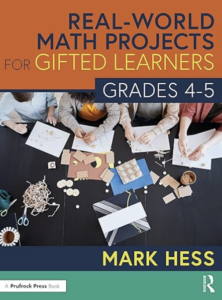Real-World Math Projects for Gifted Learners, Grades 4-5
By Mark Hess
(Routledge/Prufrock Press, 2022 – Learn more)
Reviewed by Leslie Wise
If you want to challenge your students with top-notch, engaging projects, look no further than Real-World Math Projects for Gifted Learners, Grades 4-5.
While I have spent time productively on Teacher Pay Teachers (TpT) finding a last-minute math activity for a holiday or sub lesson, teachers in gifted classrooms know that in-depth units based on standards are challenging to locate and time-consuming to create.
TpT Has Nothing on Mark Hess!
This Prufrock Press book presents six in-depth projects providing a range of activities and supporting materials to breathe life into any math classroom seeking to challenge intermediate-level gifted students.
 Mark Hess begins with some discussion of how perfectionist tendencies hinder gifted students’ growth. When they tie their self-worth to completing tasks quickly and flawlessly, they become averse to more challenging work. Yet productive struggle allows students to comprehend their ability to grow and take time to appreciate the gift of learning.
Mark Hess begins with some discussion of how perfectionist tendencies hinder gifted students’ growth. When they tie their self-worth to completing tasks quickly and flawlessly, they become averse to more challenging work. Yet productive struggle allows students to comprehend their ability to grow and take time to appreciate the gift of learning.
In the in-depth description of six projects, Hess provides engaging, multi-faceted, math-centered content to challenge and engage young, gifted mathematicians. Read on if you’re looking for material to provide instruction within the grade level standards but with higher levels of critical thinking, creativity, and real-world concepts.
Project Example: #1 The Jellyfish Flier
“Our jellyfish fliers work really well!” is the first line in Hess’s description of The Jellyfish Fliers, and he balances this enthusiasm with detailed instructions throughout the 34-page chapter.
He provides a “hook” for the lesson at the beginning with a news article about a giant jellyfish invasion, lists Unit Objectives and Common Core Math Standards, and then details six lessons within this unit to complete a jellyfish flier (yes, a flying jellyfish) based on research, engineering, marketing, math skills, and more.
Students would take an average of seven hours to complete the project. For my pull-out enrichment class, Jellyfish Fliers would absorb our time for one month, which is a reasonable length of time for an interdisciplinary project in a gifted classroom.
Hess develops a “business” context where the student teams develop and test the Jellyfish Flier prototype, using the data to create a carnival game where winning Fliers are decided using the range, the mean, the median, and the mode. Advanced math students can even use the Pythagorean Theorem to determine the displacement between various landing points of the Jellyfish Fliers during tests.
This project is a key example of the thorough approach to every lesson, which Hess makes as turnkey as possible with his descriptions, handouts, and explanations of mathematical concepts.
Success Is in the Details
This book earns its place on a gifted teacher’s shelf because of the details it provides, both supporting and for implementation. While he reasonably recommends that teachers work through each project on their own to understand the concepts and practice hands-on learning, Hess provides every step to implement these lessons.
In July, I practiced the first steps of the Jellyfish Flier in a project-based learning summer program at our school. What a hit! I had middle schoolers involved in heated conversations about the biology of jellyfish vs. the aerodynamic properties of the Jellyfish Flier. They were grateful to be doing something fun when they were expecting a math skills review, and I had a willing audience to practice the first few lessons.
Interdisciplinary, Math-Centered Projects
Four of the five other projects in the book take less time. These projects focus on geography, sports, aerodynamics, creativity and architecture – but the foundation is always an interdisciplinary, math-fueled approach to project-based learning.
Unit 2: Pikes Peak Math (approximately 9 hours) takes a look at this majestic mountain using fractions and ratios, graphic design, primary sources, reading comprehension, and game theory to explore the geographic landmark. The range of projects will engage and challenge your students’ artistic and mathematical abilities.
Unit 3: Baseball Field Landscape Architects (approximately 3 hours) provides a hands-on approach that I am reserving for our spring session. Students use “calculations, geometry, measurement, and graphic design” (p. 98) to design their own baseball fields, incorporating both innovation and the requirements of a regulation field.
Unit 4: Cones and Gnome Hat Parachutes (approximately 3 hours) allows students to experiment with 2D and 3D geometry, drafting, ratios, and the design process, as well as artistic skills and gnome trivia. I find younger students enjoy using math “tools” such as protractors, rulers and a compass, all of which are put to use here. They can also extend learning by creating gnome parachutes and marketing their prototypes. (Note this printing error: Pages 150-155 duplicate pp. 156-161.)
Unit 5: Nametag Math Project (approximately 3.5 hours) takes a simple-seeming project and adds challenging elements to work on attention to detail, perseverance, information seeking and problem-solving. The launch challenges students to develop an attractive, functional, highly specific nametag to be sold in a “teacher store” and used on student desks during the year. On top of geometry and measurements, students need to master their budgets and research the most cost-effective approach to production.
Unit 6: Scaling Skyscrapers (approximately 3.5 hours) incorporates “math to language to research to design and acting” (p. 202) in a student choice menu, all based on math and engineering. Scale and ratio are central topics here, leading to a creative writing task that will increase the diversity of this unit for all students.
These projects will inspire bored mathematicians to challenge themselves without giving up. In Real-World Math Projects for Gifted Learners, Grades 4-5, Hess provides supporting materials and decreases prep time for otherwise complex projects, making it a win for students and teachers. Detailed images, student examples, handouts, photographs, and “teacher’s guide” all make the projects accessible to any teacher with an interest in launching interdisciplinary math-centered projects to grow and challenge their gifted students.
The goal of increasing student access to opportunities motivated Leslie Wise, Ed.D., to write her dissertation on gifted education and experiential, student-driven pedagogies, which she also writes about at GiftedWeekly.com. Having taught at the intermediate and middle school levels for over 15 years, Leslie’s primary role as a Media Specialist in Middlesex, New Jersey, allows her to utilize the district’s innovative STEAM-focused library curriculum to challenge students to think critically and creatively.



